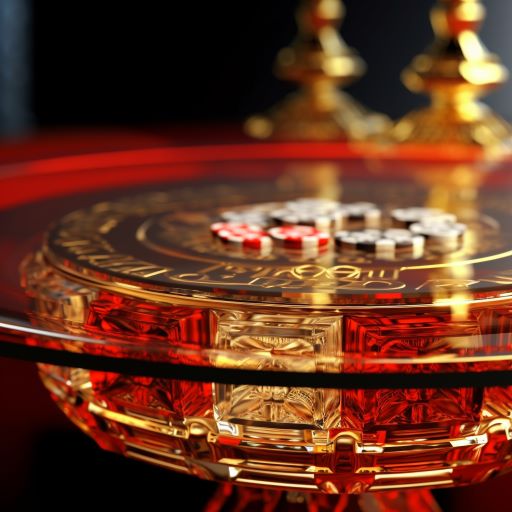What is Baccarat?
Baccarat is a popular casino game that originated in France in the mid-19th century. It is a simple game of chance that involves betting on which hand, the Banker’s or the Player’s, will have the highest point value, with the highest possible value being 9. Baccarat has three popular variants, including punto banco, baccarat chemin de fer, and baccarat banque. The game has a low house edge and is easy to learn, making it popular among new players. Although it was once a frequently played game in French casinos, it has been largely replaced by its offspring, Chemin de Fer.
What are the Odds and the House Edge in Baccarat?
In baccarat, odds refer to the likelihood of a particular outcome occurring, while the house edge refers to the advantage the casino has over the player. The odds and house edge vary depending on the type of bet placed. The two main bets in baccarat are the player bet and the banker bet. The house edge for the banker bet is 1.06%, while the player bet has a higher house edge of 1.24%. The odds of winning the banker bet are slightly better than the player bet, with a payout of 1:1 for the player bet and 0.95:1 for the banker bet. Tie bets have a much lower chance of landing, with a payout of 8:1, but a high house edge of 14.36%. To maximize their chances of winning, players should bet on the banker and avoid tie bets. It’s also important to keep track of the number of decks in play and adjust betting strategies accordingly.
How to Play Baccarat
Step 1: Select a game
When selecting a baccarat game,whether it’s in a casino or online, it’s important to understand the different variations and their rules. The most common variations are Punto Banco, Chemin de Fer, and Baccarat Banque.
- Punto Banco is the most popular and is played with six to eight decks of cards.
- Chemin de Fer is played with one deck and involves players taking turns to be the banker.
- Baccarat Banque is played with three decks and the banker position is auctioned off to the highest bidder.
It’s also important to understand the minimum and maximum bets for each game, as well as the commission charged on banker bets in some games. In Punto Banco, the commission is usually 5%, while in Baccarat Banque, it can be as high as 10%. Choosing a game with a lower number of decks can also improve your odds of winning.
In summary, when selecting a baccarat game, consider the variation and its rules, the minimum and maximum bets, the commission charged on banker bets, and the number of decks used. Understanding these factors can help you choose a game that suits your budget and playing style.
Step 2: Learn the Rules
Baccarat is a card game where the objective is to bet on the hand that will have a total value closest to 9. Two cards are dealt for both the Player and the Banker, with a third card sometimes drawn depending on the point total. The cards’ value is calculated by adding up their face value, with face cards and tens worth zero points and aces worth one point.
If the total value of a hand is more than 10, the second digit is the value of the hand. For example, a 9 and a 6 make up a five-point hand. Bets can be placed on either the Player’s hand, Banker’s hand, or a Tie, before the cards are dealt. If the point total is 8 or 9 in the first two cards dealt, it’s called a natural win, and the game is over. The winning hand is the one closest to a total of 9 points.
Step 3: Choose your bet size
When playing baccarat, the bet size can vary depending on the casino or online platform. Here are some general guidelines to keep in mind:
- Check the table minimum and maximum bet amounts before placing a bet.
- The minimum bet may be as low as $10, while the maximum bet can go up to thousands of dollars.
- There are three betting options: Player, Banker, or Tie.
- Compare the payout and house edge for each bet to determine which is worth your bankroll.
- Decide on your budget beforehand and don’t exceed it.
- Some players walk away once they’ve doubled their initial bet.
Step 4: Get Comfortable with the rules
You’ll need some sort of tactics or strategy to be successful with Baccarat so it’s important not just to learn the rules but get comfortable with them too. They’re not actually difficult and the game is designed to be easy to play without too many complications.
Objective of the Game:
Baccarat is a card game where players bet on the outcome of each hand. The objective of the game is to have a hand that is closest to a total of 9 points. Players can bet on the Banker’s hand, the Player’s hand, or a Tie.
Card Values:
In Baccarat, the cards are valued as follows:
- Ace has a value of 1
- Cards 2 through 9 have their face value
- 10, Jack, Queen, and King have a value of 0
Gameplay:
At the beginning of the game, players place their bets on the outcome of the hand. Two cards are dealt for each of the Banker’s and the Player’s hands. If the total value of either hand is 8 or 9, it is considered a natural win. If the total value is less than 8, the player may draw a third card. The rules for drawing a third card are fixed and depend on the total value of the first two cards. Once the hands are played out, the hand closest to 9 wins.

Tips:
To improve your chances of winning, set a budget in advance and stick to it. Start with mini baccarat games that have lower table limits and fewer players. Avoid betting on a Tie, as the odds against one of the players winning are much better. Bets on the Banker have a higher chance of winning, with odds of 44.6%. Don’t bet against streaks and start with small amounts while betting. Remember that counting cards doesn’t work in this game. Finally, take advantage of offers and bonuses offered by the casino. By keeping these tips in mind and understanding the rules of the game, players can enjoy a fun and exciting game of Baccarat.
Step 5: Start practicing
If you’re interested in practicing playing baccarat, there are a few things you can do to get started. Look for free or low-stakes games at your local casino or online. Mini baccarat games are perfect for beginners, as they have lower table limits and a smaller number of players, making the experience less intimidating. When choosing a strategy to practice, consider starting with bets on the banker, which have the best odds of winning. Remember to start with small amounts and never wager all your money on a single bet. It’s also important to track your progress over time to see how your skills are improving. Keep studying the winning patterns and be aware of when to draw your cards. With practice and patience, you can become a skilled baccarat player. Good luck!
Step 6: Get ready for your first game
Preparing for your first game of baccarat can seem intimidating, but with a bit of knowledge and preparation, you’ll be ready to play in no time. First, set a budget in advance and stick to it. Start with mini-baccarat games, which have lower table limits and fewer players. Choose a table with fewer decks of cards if possible. Avoid betting on a tie, as the odds are not in your favor. Instead, bet on the banker, as the chances of winning are higher. Don’t bet against streaks and start with small amounts. Remember, counting cards doesn’t work in baccarat, so study the winning patterns instead. During gameplay, each player will find three bet boxes for Player, Banker, and Tie. Once bets are placed, four cards are dealt on the table. If your total is lower than 6 or 7, draw a card. Finally, take advantage of offers and bonuses offered by the casino.
Step 7: Understand a winning hand
In baccarat, the goal is to bet on the hand that will have the highest score, either the Player or the Banker. The winning hand is the one with a score closest to 9, where face cards count as zero and aces count as one. If the total of the first two cards dealt is 8 or 9, this is called a “natural win”, and the game ends with the higher hand winning. If neither hand has a natural win, an additional card may be drawn to determine the winner. When both Player and Banker are dealt 7 or less, an additional drawing takes place. The winning hand can also be determined by placing optional side bets on specific outcomes, such as the Dragon7™ or Panda 8™.
Step 8: Place your bet
To place a bet in baccarat, approach the table and choose one of the three betting options: the player hand winning, the banker’s hand winning, or a tie. Each player has three bet boxes on the felt table top. Place your bet in the box corresponding to your chosen outcome. The minimum and maximum bet amounts vary depending on the casino. Once the bets are placed, four cards are dealt on the table, and the game proceeds.
Step 09: Be aware of Player Hand Third Card Rule
In baccarat, the player may draw a third card under certain circumstances. If the player’s first two cards total 0 to 5, a third card is drawn. However, if the total is 6 or 7, no third card is drawn. If the player has a total of 8 or 9, this is called a natural and no third card can be drawn. The banker hand follows the same rules as the player hand in determining whether it will receive a third card. If the player does draw a third card, the banker’s actions are determined by the score. For example, if the player’s third card is a 4, the banker will draw a third card if their first two cards total 0 to 5, but will stand if their total is 6 or 7. It’s important to note that these decisions are not based on strategy and are instead covered by game rules and actioned by the dealer.
Additional Tips for Winning at Baccarat
Bet on the Banker instead of the Player
In a game of baccarat, it is more advantageous to bet on the Banker rather than the Player. This is because the house edge of the Banker’s bet is only 1.06 percent, while the house edge of the Player’s bet is 1.24 percent. Additionally, the Banker wins just over 50% of the games, making it a safer bet. Although a 5% commission is charged on winnings from the Banker’s hands, this is still the best bet in the game. It is recommended to avoid tie bets, as they have a house edge of around 14.4%.
Know the House Edge in Baccarat
In baccarat, the house edge is the advantage that the casino has over the player. The house edge for the banker’s hand is 1.06%, while the player’s hand has a house edge of 1.24%. This means that if you bet on the banker’s hand, you have a slightly better chance of winning. The tie bet has a much higher house edge of 14.36%, making it a poor choice. It’s important to keep the house edge in mind when playing baccarat, as it affects your chances of winning.
Play at a Higher Stake
Playing at a higher stake in baccarat can increase your chances of winning and earning more significant profits. When playing at a higher stake, you have the potential to hit a winning streak, which can result in significant payouts. However, it’s crucial to manage your bankroll carefully to avoid losing all your money in one sitting. Set a budget in advance and stick to it, and never wager all your money on a single bet. Consider staking 10 units for each wager with a limit of 200 units per session, followed by a complete break. Remember to bet on the banker, which has the best odds of winning, and follow bank streaks, but don’t be over-aggressive. With these tips, playing at a higher stake can increase your chances of winning, but it’s essential to manage your bankroll carefully to avoid losing everything.
4. Keep Track of the Point Values
To keep track of the point values in baccarat while playing, it is essential to understand the point system and how it affects the outcome of the game. Here’s a step-by-step guide to calculating the point values for the player and banker hands:
- Each card in baccarat has a point value. The 2 through 9 cards are worth their face value, while 10s and face cards are worth zero points. Aces are worth one point.
- When the total points reach a double-digit number, only the second digit is counted. For instance, a hand with cards 6 and 8 adds up to 14, but the point value is 4.
- The highest possible hand value in baccarat is nine. If the total points of either the player’s or banker’s hand are 8 or 9 on the first two cards, this is a natural win, and the game is over.
- If the total points of either the player’s or banker’s hand are less than 8, a third card may be drawn according to specific rules. The player’s hand is always played first, and the banker’s hand will depend on the player’s hand’s third card.
- After the hands are played out, the winning hand is the one closest to a total of 9 points. If a player bets on the winning hand, they win the bet according to the payout table.
Understanding the point system in baccarat is crucial to make informed bets and increase the chances of winning. By keeping track of the point values, players can predict which hand will have a point value closest to nine and place their bets accordingly. It is also important to note that the house edge in baccarat is 2.65%, which is relatively low compared to other casino games. By following these steps, players can enjoy playing baccarat while also increasing their chances of winning.
5. Consider Other Games with Lower House Edge
Although baccarat is known for having a relatively low house edge compared to other casino games, it’s important for players to consider all options when looking to win. With a house edge of 1.06% for betting on the banker and 1.24% for the player, baccarat can still be a profitable game for some. However, the house edge for tie bets is a staggering 9.5%, making it a risky and unwise choice. Additionally, the payout for correctly predicting the total number of cards dealt is only 2:1 or 3:2, with a house edge of 4.35% or 5.27%. Considering other games with even lower house edges, such as blackjack or craps, may be a smarter decision for players looking to maximize their chances of winning.
6. Use a Strategy Card
A strategy card is a useful tool that can improve your chances of winning at baccarat. It is a small card that contains information about the game’s rules, betting options, and other important details. By using a strategy card, players can quickly and easily reference important information during the game, helping them make more informed decisions. This can increase the likelihood of making successful bets and ultimately lead to more wins. Additionally, using a strategy card can help players build their knowledge and understanding of the game, making them more confident and skilled players in the long run.
7. Keep Track of the Cards in Play
Card counting is not an effective strategy in baccarat as the game is played with multiple decks of cards and the cards are shuffled after each round. However, players can keep track of the patterns in the game and adjust their bets accordingly. One common strategy is to bet on the banker’s hand as it has a slightly higher chance of winning. Another strategy is to look for streaks, whether it’s a streak of banker or player wins, and adjust bets accordingly. It’s important to start with small bets and gradually increase them as you observe the patterns in the game. Additionally, taking advantage of bonuses and offers from the casino can help increase your chances of winning. Remember to never bet all your money on a single bet and to keep a game plan and budget in mind.
8. Focus on the Big Picture
In baccarat, it’s important to focus on the big picture. This means thinking beyond individual hands and considering the overall strategy of the game. Start by setting a budget and placing bets wisely, choosing the banker’s hand for the best odds. Pay attention to winning patterns and avoid betting on ties. Remember to draw cards strategically and take advantage of casino offers. By keeping the big picture in mind, players can increase their chances of success in this strategic game.
9. Don’t Get Caught Up in the Excitement
Baccarat is an exciting game that can easily sweep players up in the moment. To avoid getting carried away, players should decide on their budget in advance and treat it as money they would spend on a night out. It’s best to start with mini baccarat games as they have lower table limits and fewer players, making the experience less intimidating. Players should also avoid betting all their money on a single bet and never bet on a tie. Instead, they should bet on the banker’s side, as it offers the best chance of winning. It’s important to set betting and time limits, and to avoid systems that claim to guarantee wins. By following these tips, players can enjoy the game responsibly and make rational decisions.
10. Keep a Steady Bankroll
When playing baccarat, it’s important to keep a steady bankroll to avoid overspending. First and foremost, determine your budget before you start playing. Treat this money as you would for a night out, not expecting to bring it home. Start with small bets, and never wager all your money on a single bet. Be aware that betting on a tie is probably the worst bet you can do, as the odds against one of the players winning are much better. Instead, bets on the banker are the best as the chances of winning while making this bet are 44.6%. Also, take advantage of offers and bonuses offered by the casino. Finally, practice good stake management, and set your bankroll and time limits before you start playing. Stick to your budget and take a break if you need to. By following these tips, you can keep a steady bankroll and enjoy the game without overspending.
FAQ
What is Baccarat?
Baccarat is a card game played in casinos, where players bet on one of two hands – the Banker’s hand or the Player’s hand – to win. It’s an easy game to learn, with no technical skill required, and offers some of the best odds in the casino. Baccarat originated in France in the mid-19th century and was once one of the most popular games in French casinos. Today, it can still be found in high-stakes sections of many casinos around the world.
How do you play Baccarat?
Baccarat is a simple game where players bet on one of three outcomes: their hand winning, the banker’s hand winning, or a tie. The dealer deals two hands on the table – the banker’s hand and the player’s hand. The goal is to bet on the winning side. Tens and face cards are worth zero points, and other cards are worth their face value except for the Ace, which is worth one point. If the value of a hand is a two-digit number, only the second digit is counted. Players can draw another card if their total is less than six. The banker bet wins most often, but a 5% commission is applied. The player wins 44.63% of the time, and the banker wins 45.87%. Cheating in baccarat is possible through past posting, where players add chips to their bet after winning a hand.
Example scenario: The dealer deals two cards to the banker’s hand (Hand A) and two cards to the player’s hand (Hand B). The banker’s hand has a 7 and a 6, worth 3 points. The player’s hand has a 9 and a 3, worth 2 points. Since the banker’s hand has a higher value , the banker wins, and the players who bet on the banker’s hand win the round.
What is the House edge in Baccarat?
The house edge in Baccarat refers to the advantage that the casino has over the player. It affects the game by determining the likelihood of winning or losing a bet. The lower the house edge, the better the odds of winning. In Baccarat, the banker bet has a lower house edge of 1.06% compared to the player bet’s 1.24%. The tie bet has a significantly higher house edge of 14.36%, making it a poor choice for players.
How do you bet in Baccarat?
In Baccarat, there are three types of bets that players can place: the Banker’s bet, the Player’s bet, and the Tie bet. To place a bet, players simply need to walk up to a Baccarat table and indicate which outcome they want to bet on. The Banker’s bet refers to betting on the dealer’s hand, while the Player’s bet refers to betting on the player’s hand. The Tie bet is a bet on both hands ending up with the same value. Once bets are placed, the dealer deals two cards to the Banker’s hand and two to the Player’s hand. The goal of the game is to bet on the winning side, which is determined by the total point value of each hand. The hand with the closest value to 9 wins. It’s important to note that players do not receive any cards themselves and are simply betting on the outcome of the game.
What are the different types of bets in Baccarat?
In Baccarat, players can place bets on one of three outcomes: the player’s hand winning, the banker’s hand winning, or a tie. The most common bet is the player or banker bet, where players bet on which hand will win. The payout for this bet is even money, with a 1.06% house edge for the banker bet and a 1.24% house edge for the player bet. The tie bet is less common, where players bet that both hands will have the same value. The payout for this bet is 8:1, but the house edge is much higher at 14.36%. In addition to these bets, there are also side bets available, which offer big payouts but come with lower odds of winning or higher house edges. These include the ‘Bellagio Match’ side bet, where players bet on the player or banker having three of a kind in their hand with a payout of 75:1 and a house edge of 5.27%. It’s important to compare the payouts and house edges of each bet before placing a wager.
What is a Banker Hand in Baccarat?
In Baccarat, the Banker’s hand is one of two hands dealt, with the other being the Player’s hand. The Banker’s hand is not controlled by the player and depends on the value of the Player’s hand. The Banker will draw a third card if the Player’s hand has a total of 0-5 points, but will stand if the Player’s hand has 6 or 7 points. The goal of the Banker’s hand is to have a score closest to 9, with face cards worth 0 and aces worth 1. For example, if the Banker has a 7 and a 5, the total is 2.
What is the best way to manage your bankroll when playing Baccarat?
Managing your bankroll is crucial when playing Baccarat. Firstly, determine your bankroll before starting to play. Set a budget and stick to it. Don’t chase losses and avoid excessive wagering. Set betting and time limits and quit when you’ve lost your bankroll or when your time is up. It’s also wise to set a winnings ceiling. Play the Banker’s side as it has a better chance of winning, and never bet on ties. Don’t waste your time and money on systems that claim to guarantee wins. Instead, practice playing Baccarat for free to develop a proper betting strategy that fits your bankroll. Remember, Baccarat is a fast-paced game, so it’s essential to be disciplined and have a plan to manage your bankroll effectively.
What are the odds of winning a bet on Baccarat?
Baccarat is a game of pure chance, so you can’t improve your odds using skill. The odds of winning are lower than blackjack, but higher than roulette and poker, as long as you play with an optimal strategy. Betting on the Banker hand offers the best odds of winning at baccarat. The house edge of the Banker’s bet is 1.06 percent, while the house edge of the Player’s bet is 1.24 percent. The odds of winning a bet on the Banker are slightly better, but the casino will take a commission of around 5 percent on this bet. Tie bets have a very low chance of landing, less than 10 percent, and a high house edge of 14.36 percent. It’s best to avoid tie bets altogether. Remember that totals above nine require you to drop the first digit to get the true value, and the closest hand to nine wins.
How do Picture cards and Digits affect the game of Baccarat?
In Baccarat, picture cards (i.e. 10, Jack, Queen, and King) have a value of zero, while the digits 2-9 are counted based on their face value number. Additionally, an Ace card has a value of 1. When calculating the totals of the hands, the final digit of the sum is used, and any two-digit number is counted as the value of the second digit. For example, if a player is dealt a 6 and a 7, the total is 13, but the final score is 3. Similarly, if a player is dealt a 9 and an 8, the total is 17, but the final score is 7. The aim of the game is to have the hand you’re betting on, either the player or the banker, be the best hand of the two dealt, with the winning hand being the one with a score where the final digit when all the pips are added up is the closest to nine.




